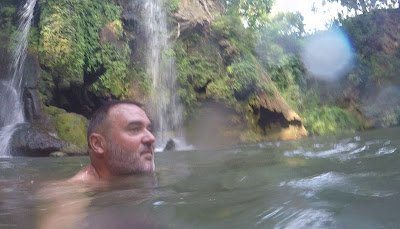Winter camping
It was -3°C when we got up this morning on our last day in Venosc, at Champ du Moulin campsite in the French alps.
Despite the outside temperature we've been very cosy in our VW T5 California campervan, but that's through thorough preparation and having the right accessories.
Most important, I think, has been the insulated screen from Pucer Screens. A silver insulated layer that wraps around the pop-top roof. We purchased it for around £120 a couple of months ago from a small business in the UK. It was delivered in a couple of days and fits perfectly.
Then we've got a further layer in the Cali-Topper we've had from day one. It's a military-grade fabric protective cover which we've used in all seasons. At £400 it is quite pricey but it keeps the wind out and the rain off. After a year of camping our van's roof fabric is as clean as the day she rolled out of the factory because it isn't exposed to the elements.
Both these additional layers helped keep the warmth in.
The heat came from three sources. Firstly, as we were on fixed-price electric hookup we brought along a 1500 watt oil-filled radiator. It takes up little room, sitting under the table out of the way, and provided most of our heat. Then we used the van's parking heater, installed as an optional extra when we ordered her. It burns diesel from the main fuel tank and is near silent and very effective. The diesel heater alone would have kept us warm, but why use your fuel when you've paid for electricity?
Finally we've had an electric blanket on the roof-top mattress for a couple of months. When you pull down the bed at night it can still be cold despite the temperature in the living space and so it takes the initial chill off.
During the day we had the radiator on all the time and the parking heater on as necessary to get a comfortable temperature. At night we've left the radiator on, positioned under the entry hole for the roof-top bed, and turned of the parking heater. The electric blanket was only used to warm the bed before getting in.
So, as I said, we've been lovely and warm despite the snow on the ground in a campsite that gets no sun at all in the winter.
There are some other things worth knowing about winter camping, particularly at occasionally sub-zero temperatures. Our campsite was very sheltered from wind and so we opened the wind-out awning and left it up for a week. This was all very well until we came to leave. There was ice on both the top and bottom of the fabric and it took a few jugs of hot water to make it malleable enough to wind back in. It took a few jugs of hot water to warm the ground enough to get the pegs out too. In hindsight, given that we didn't have rain or snow, it would have been better not to have used the awning.
A plus point of temperatures hovering around zero is that you don't need a fridge. We have a large garden storage box which can be left outside, so as well as storing our walking boots and wellies, we've also kept a box of cold food. The food has kept perfectly.
There are a couple of winter essentials we haven't used but are nice to know are there. A collapsible snow shovel fits nicely in the tailgate with the chairs. Then we have snow chains which I was half expecting for us to need to exit the campsite.
And so although we didn't really know what to expect from camping in the alps at Christmas, we do seem to have covered all bases. If you make sure you've got the right kit there's no reason not to camp 52 weeks a year.
Anything I'd do differently next time? Bring skis!





Comments
Post a Comment